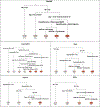Disparities in adherence and emergency department utilization among people with epilepsy: A machine learning approach
- PMID: 37393863
- PMCID: PMC10528555
- DOI: 10.1016/j.seizure.2023.06.021
Disparities in adherence and emergency department utilization among people with epilepsy: A machine learning approach
Abstract
Purpose: We used a machine learning approach to identify the combinations of factors that contribute to lower adherence and high emergency department (ED) utilization.
Methods: Using Medicaid claims, we identified adherence to anti-seizure medications and the number of ED visits for people with epilepsy in a 2-year follow up period. We used three years of baseline data to identify demographics, disease severity and management, comorbidities, and county-level social factors. Using Classification and Regression Tree (CART) and random forest analyses we identified combinations of baseline factors that predicted lower adherence and ED visits. We further stratified these models by race and ethnicity.
Results: From 52,175 people with epilepsy, the CART model identified developmental disabilities, age, race and ethnicity, and utilization as top predictors of adherence. When stratified by race and ethnicity, there was variation in the combinations of comorbidities including developmental disabilities, hypertension, and psychiatric comorbidities. Our CART model for ED utilization included a primary split among those with previous injuries, followed by anxiety and mood disorders, headache, back problems, and urinary tract infections. When stratified by race and ethnicity we saw that for Black individuals headache was a top predictor of future ED utilization although this did not appear in other racial and ethnic groups.
Conclusions: ASM adherence differed by race and ethnicity, with different combinations of comorbidities predicting lower adherence across racial and ethnic groups. While there were not differences in ED use across races and ethnicity, we observed different combinations of comorbidities that predicted high ED utilization.
Keywords: Adherence; Disparities; Emergency department utilization; Machine Learning.
Copyright © 2023 British Epilepsy Association. All rights reserved.
Conflict of interest statement
Declaration of Competing Interest The authors declare that there is no direct conflict of interest regarding this study. Dr. Wyatt P. Bensken has received support for this work from the National Institute on Minority Health and Health Disparities of the National Institutes of Health and serves on the Editorial Board of the Journal Neurology. Dr. Omar I. Khan has received personal compensation as an Contributing Editor for Elsevier and has received salary support from two federal agencies, the NIH and Veterans Affairs and has an immediate family member who receives salary support as a clinical reviewer with the FDA. Dr. Barbara C. Jobst has received research support from Neuropace, Inc., as well as from the National Institutes of Health, the Center for Disease Control, the Diamond Foundation, and the National Science Foundation. She also serves as Associate Editor of the Journal Neurology. Dr. Martha Sajatovic has been funded by Nuromate, Otsuka, Alkermes, International Society for Bipolar Disorders (ISBD), National Institutes of Health (NIH), Centers for Disease Control and Prevention (CDC), Patient-Centered Outcomes Research Institute (PCORI); served as a consultant for: Alkermes, Otsuka, Janssen, Myriad, Health Analytics, Frontline Medical Communications. Royalties: Springer Press, Johns Hopkins University Press, Oxford Press, UpToDate; and been compensated for preparation of CME activities: American Physician's Institute, MCM Education, CMEology, Potomac Center for Medical Education, Global Medical Education, Creative Educational Concepts, Psychopharmacology Institute. Dr. Siran M. Koroukian is supported by grants from the National Cancer Institute, Case Comprehensive Cancer Center (P30 CA043703); National Institutes of Health (R15 NR017792, and UH3-DE025487); The American Society (132,678-RSGI-19–213–01-CPHPS and RWIA-20–111–02 RWIA); and by contracts from Cleveland Clinic Foundation, including a subcontract from Celgene Corporation.
Figures


References
-
- Kobau R, Zahran H, Grant D, Thurman DJ, Price PH, Zack MM. Prevalence of active epilepsy and health-related quality of life among adults with self-reported epilepsy in California: California Health Interview Survey, 2003. Epilepsia. 2007;48(10):1904–1913. - PubMed
-
- Geerts A, Brouwer O, van Donselaar C, et al. Health perception and socioeconomic status following childhood-onset epilepsy: the Dutch study of epilepsy in childhood. Epilepsia. 2011;52(12):2192–2202. - PubMed
-
- Elliott JO, Charyton C, Lu B, Moore JL. Serious psychological distress and health outcomes for persons with epilepsy in poverty. Seizure. 2009;18(5):332–338. - PubMed
-
- Sillanpaa M Learning disability: occurrence and long-term consequences in childhood-onset epilepsy. Epilepsy Behav. 2004;5(6):937–944. - PubMed
-
- Konda K, Ablah E, Konda KS, Liow K. Health behaviors and conditions of persons with epilepsy: a bivariate analysis of 2006 BRFSS data. Epilepsy Behav. 2009;16(1):120–127. - PubMed
MeSH terms
Grants and funding
LinkOut - more resources
Full Text Sources
Medical

